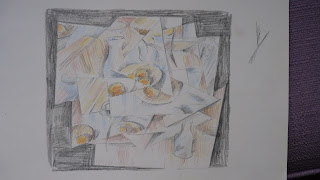Naïve sounds like an insult but in art it covers a wide range of art in which either deliberately or innocently artists draw and paint without worrying about the academic standards of proportion, perspective realistic shading etc. The produce art in a similar way as children, they just draw what seems right.
A famous artist was Alfred Wallis a retired Cornish fisherman
quote from Wikipedia:
His paintings are an excellent example of naïve art; perspective is ignored and an object's scale is often based on its relative importance in the scene, giving many of his paintings a map-like quality. Wallis painted seascapes from memory, in large part because the world of sail he knew was being replaced by steamships. As he put it, his subjects were "what use To Bee out of my memory what we may never see again..."[2] Having little money, Wallis improvised with materials, mostly painting on cardboard ripped from packing boxes and using a limited palette of paint bought from ships' chandlers.
Two Boats Moving Past a Big House.
He was championed by some of the artists of his day and became well known.
The interesting thing is when someone in class says of a drawing or painting 'it's all wrong' often it looks a bit like this kind of art. So is it all wrong?
It can look either clumsy and amateurish or it can look charming and unsophisticated in a pleasing way.
An artist who chose to draw and paint in a sort of naïve manner despite having been well trained in 'proper drawing' was Lowry, now you can tell that he had a good knowledge of 'proper drawing and of proportion and perspective, so maybe Naïve isn't entirely appropriate. The Level Crossing.
The style is used a lot, you often see it in galleries, makes good cards so will often see it featured on greeting cards because it is a kind of 'happy style' Local artist Joanne Wishart has a sort of sophisticated naïve style, which sounds contradictory, or one of those oxymorons! but you will find the style goes from very simple 'my 4 yr old could do better' to a more developed style which still has the feeling of freedom from academic realism. Joanne has a shop in Cullercoats, do visit when lockdown is over, but you can see her work online, really jolly and very accomplished.
LOOK UP NAIVE ART AND YOU WILL FIND MILLIONS OF IMAGES, IT IS WORLD WIDE POPULAR. Linked to other movements such as Folk Art and Outsider Art
here is an example.
https://www.etsy.com/uk/shop/spiralforeststudio?ref=simple-shop-header-name&listing_id=263722455
Well that's enough for now. do have a look, it looks easy but you will find the grown up in you resists your attempts to draw like a child!
As ever doing a number of sketches, preferably form memory or else keeping the photo if you are suing it, at some distance trying to get the feeling of the scene rather than painstakingly copying.


























